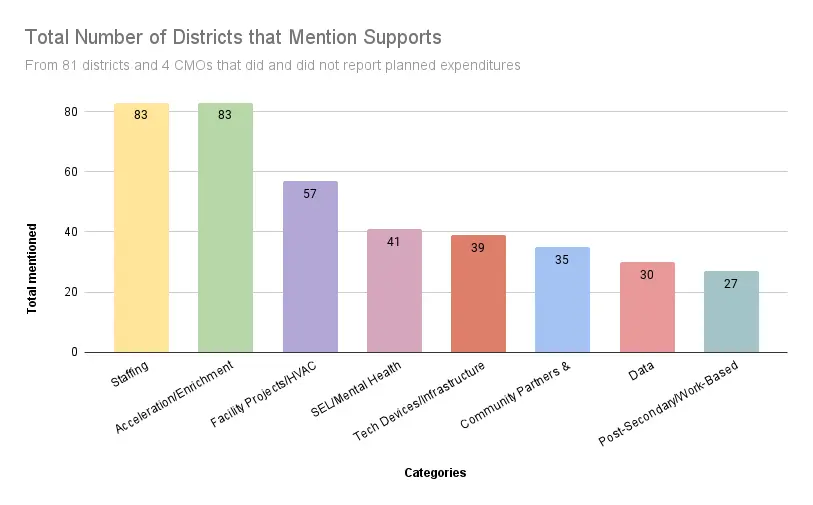As part of ongoing research on postpandemic recovery efforts in New England, we collected and reviewed 85 federal Covid-19 relief spending plans from districts and charter school systems in the region. Our analysis is not a comprehensive assessment of all school and district spending plans across New England. Instead, we hope this information provides a general understanding of districts’ priorities as they emerge from the most disruptive phase of the pandemic. We published a fact sheet with more details from our analysis in September 2022.

Our analysis raised key questions about New England schools’ spending priorities, including:
Will plans for large staffing investments be sustainable?
Planned expenditures for staffing totaled more than 40% of all reported funds across our sample. This trend of allocating the majority of dollars for staffing extends beyond New England. But it’s unclear if using temporary funds to hire new employees is sustainable. Positions supported by federal relief funding will require new sources after the recovery dollars dry up in 2024. In one survey of school leaders, over half reported they will have to end contracts with specialist staff when they hit the deadline to spend the federal money. Districts that have to make major staffing cuts could disproportionately impact students in lower-income schools, especially if the newest hires are let go first.
Meanwhile, some districts are creatively using federal relief dollars to help boost the skills of current educators, according to their published plans. Waterbury Public Schools (CT) and Newbury Public Schools (RI), for example, plan to cover training costs for current staff to receive endorsements in high-needs areas, such as social and emotional learning, teacher leadership, and teaching English learners. While investments in existing talent will help districts support their current staff, long-term staffing expenses may be difficult to sustain.
Will investments in core instruction accelerate learning for students furthest behind?
While nearly all districts’ plans included spending federal dollars on academic acceleration and learning enrichment, fewer than half outlined plans to spend money on high-dose tutoring, which research shows can be particularly effective for students. Among the districts that specified dollar allocations, most planned expenditures on general core instruction, such as new curriculum and materials. Tutoring initiatives made up only 6.5% of planned funds – roughly ten times less than allocations for core instruction.
We were surprised by this low percentage of funding planned for tutoring, given pandemic-era declines in reading and math scores and the need for increased and consistent intervention. Districts were not federally required to detail their planned expenditures, so few plans noted which grade levels would receive tutoring, or which students would be prioritized.
Most districts allocated considerably more relief dollars for extended learning opportunities, which are also effective at improving student outcomes. However, combined funding planned for tutoring and extended learning opportunities among school systems in the region still falls short of the total funding planned to increase core instruction in reading and math.
Investments in curriculum, instruction, and learning materials will likely benefit a broad range of students. But without funding for more targeted academic interventions, students who fell the furthest behind their peers during school shutdowns and periods of remote learning may continue to struggle.
Are districts investing enough in social-emotional and mental health support services?
Planned investments in social-emotional learning programs and mental wellness initiatives made up only 4% of all relief spending, and investments in helping staff support students’ emotional needs and mental health made up 3.3% of all relief spending. However, districts did not always specify how these investments would support students’ social and emotional development.
New Haven Public Schools (CT) described its plans to invest in outdoor classrooms and cited related, supporting research. New Haven is the outlier, though. The overall planned level of funding in these supports may not be sufficient, considering how the pandemic has caused widespread harm to students’ mental health.
The spending plans we examined only cover federal Covid-19 relief dollars, and we don’t know whether these districts have allocated additional money in their regular budgets on support for students’ social and emotional health. Other districts could be investing in new strategies like New Haven, but these may not be clearly defined as social and emotional learning or mental health supports in their federal spending plans.
Can external pressures influence plans for the remaining federal relief money?
Only 19 districts reported spending allocations to increase or expand post-secondary education pathways or career training, but some outlined creative plans for the federal relief funds. West Hartford Public Schools (CT) plans to provide additional job training opportunities by leasing a building that students will operate as a bookstore. The district also set aside funds to create computer science workshops in each high school to help students better understand the field as a potential career choice. Colebrook School District (NH) plans to work with community partners and state consultants to expand work opportunities for students.
Recently, all six of New England’s state K-12 education chiefs signed a resolution supporting a regional collaboration to support student learning and build college and career pathways – a positive sign that post-secondary pathways are at the forefront of New England’s priorities. The majority of college-readiness and work-based learning opportunities mentioned in spending plans were in Connecticut and Massachusetts, but this new coalition may prompt other regional systems to support similar initiatives with their remaining relief money.
Looking ahead: How can we learn more about what’s happening on the ground?
Our analysis reveals dozens of New England districts’ federal spending priorities as they move forward with pandemic recovery. Some outline unique plans, but the vast majority of districts do not appear to be investing in new innovations, or using evidence-based recovery tactics.
It’s important to note that these plans do not yet reflect actual spending, nor do we know how these plans were made.School leaders had to create plans quickly, all while trying to meet certain federal requirements – like gathering stakeholder input and meeting a minimum set-aside for learning acceleration efforts – potentially with little guidance or support.
We will soon conduct interviews with school leaders in New England to better understand districts’ actual expenditures, the decision-making process that drove these plans, and the challenges to implementing them.






Voice and choice: New England students highlight which pandemic-era changes should stay—and which should go
Lisa Chu
Research Analyst, CRPEMaddy Sims
Senior Fellow, CRPE